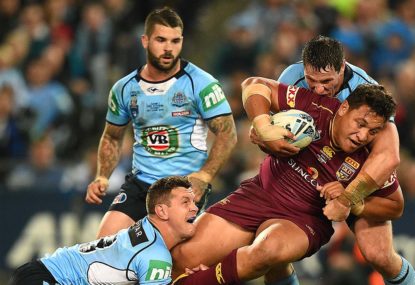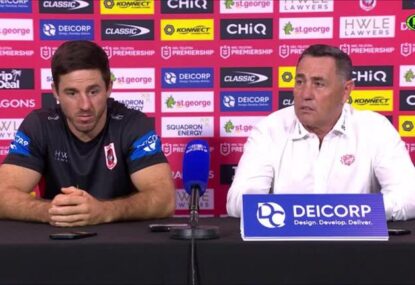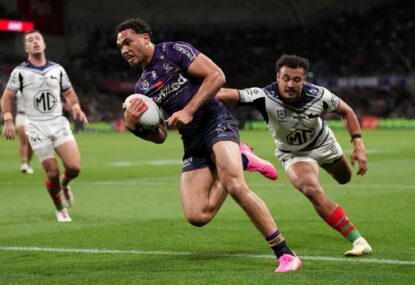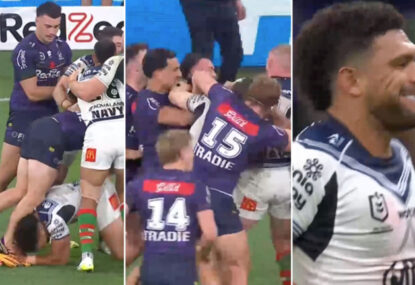For as long anyone remembers, professional rugby league clubs have practiced some sort of martial arts training. Boxing is so common, indeed, that a number of league players have pursued boxing careers of some sort. Wrestling, however? Wrestling is a dirty word.
To most fans, I hardly need to explain why wrestling is condemned.
Often first attributed to Craig Bellemy’s Melbourne Storm, it is generally accepted that certain techniques present dangers to both players’ joints and necks, all the while committing the perennial sin in our modern game: slowing down the play.
But these new additions – focusing on upper-body control and manipulation in three-man tackles – are not the only, or even the best-attested wrestling techniques in rugby league.
In many ways, wrestling actually helps the game.
Paul Kent claimed in a recent article that league could be described using Vince Lombardi’s famous quote: “Football is not a contact sport, it’s a collision sport.” However, this is not quite on the mark.
American football is indeed a collision sport, but rugby league has always had an element of contact, with post-collision holding a must. Regardless of how much people lament the lack of ‘true’ collisions in the modern game after the banning of the shoulder-charge, it is not like holding is new, and it is here where wrestling can come in.
There are, in fact, a number similarities – probably organic – between rugby league contact and wrestling contact, and I would like to present two instances in which wrestling training can be advantageous to both the action of the game, and player safety. Both are associated with the core wrestling fundamentals of proximity, level-change and body control.
[latest_videos_strip category=”rugby-league” name=”League”]
The first of these is in defence. The fundamental set-up for the most basic front-on tackle is actually strikingly similar to the fundamental set-up for ‘shooting’ a takedown in wrestling. Both involve almost identical body dynamics. For example: bending down with the knees, rather than at the waist, in order to position the body closer to the opposition’s centre of gravity; keeping the head and upper-body upright, so to allow proper use of shoulders and arms; and deriving power from a leg-drive, rather than ‘muscling’ an opponent with the arms or back.
Using wrestling training in conjunction with traditional tackle training could equip players, particularly young players, with the knowledge to best protect their body, while most effectively taking down the opposition. Wrestling would get them used to these positions, and promote good habits when in-game situations arise.
Another advantageous aspect of wrestling, and one which could perhaps be put to more use, is takedown defence.
Used by the player with the ball, successful takedown defence is of great benefit to attacking teams, not only to bump off tacklers but more importantly to remain in a good position after the tackle to play the ball.
Wrestling defence is often expressed in terms of lines: head, arms, forearms, and hips. Obviously not all of these are useful in the context of a football game, especially using the head as a line of defence. However, the positioning of the hands, arms, and particularly the hips, are crucial to attacking players. The technique of sprawling is especially useful to a player being tackled, and is not at all an uncommon tool used in football.
A good sprawl involves bumping the hips back off the attacker, sprawling the legs flat behind you and putting the weight of the upper body on top of the opposition. If a player with the ball can sprawl successfully, and have a tackle called while still on top of the first defender who attempted the tackle, they are in a brilliant position to play the ball quickly while one of the markers is out of place.
Practicing the sprawl, along with more traditional positional training, is of great benefit to rugby league, and wrestling skills in these departments should not be maligned.
However, it would be remiss of me not mention post-contract body control. It is the actions of defenders after initial contact, where people start to see the negative impacts of wrestling. With three-man tackles now the norm, a tackled player is more often than not manipulated onto their back with techniques focused on controlling the arms, or even neck, of a tackled player.
Some of these techniques are associated with wrestling, however it is the martial arts which focus on joint manipulation, notably Brazilian jiu jitsu and Judo, which are training players to manipulate limbs and necks into passive positions.
South Sydney employ well known Gracie blackbelt Alex Prates, while Professor Marcos Nevel is a blackbelt who not only works with the Bulldogs, but also with the NSW Blues.
Seeing an attacking player slowly manipulated into submissive positions is hardly scintillating viewing, but when wrestling is used to safely takedown an opponent, or protect from being tackled, it is not only an important tool in rugby league, but an interesting one.



































































































